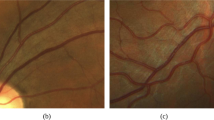Abstract
The tortuosity of retinal blood vessels is an important diagnostic indicator for a number of retinal pathologies. We applied robust quantitative tortuosity metrics, which are well suited to automated detection and measurement, to retinal fluorescein images of normal and diseased vessels exhibiting background diabetic retinopathy, retinitis pigmentosa and retinal vasculitis. We established the validity of the mean tortuosity (M) and the normalized root-mean-square tortuosity (K) by their strong correlation with the ranking of tortuosity by an expert panel of ophthalmologists. The low prevalences of the diseased conditions in the general population affect the classification process, and preclude the use of tortuosity for screening for all of these conditions simultaneously in the general population. Tortuosity may be useful as a screening test for retinitis alone, and may be useful for distinguishing diabetic retinopathy or vasculitis from normal in a discretionary (i.e. referred) population.




Similar content being viewed by others
References
Aschner P (1998) Current concepts of diabetes mellitus. Int Ophthalmol Clin 38:1–10
Aslam T, Fleck B, Patton N, Trucco M, Azegrouz H (2009) Digital image analysis of plus disease in retinopathy of prematurity. Acta Ophthalmol 87:368–377
Boone JM, Lindfors KK, Siebert JA (2002) Determining sensitivity of mammography from screening data, cancer incidence, and receiver-operating characteristic curve parameters. Med Decis Mak 22:228–237
Bullitt E, Gerig G, Pizer SM, Lin W, Aylward S (2003) Measuring tortuosity of the intracerebral vasculature from MRA images. IEEE Trans Med Imaging 22:1163–1171
Capowski JJ, Kylstra JA, Freedman SF (1995) A numeric index based on spatial frequency for the tortuosity of retinal vessels and its application to plus disease in retinopathy of prematurity. Retina 15:490–500
Cohen J, Cohen P, West SG, Aiken LS (2002) Applied multiple regression/correlation analysis for the behavioral sciences, 3rd edn. Lawrence Erlbaum, New York, p 538
Dougherty G, Varro J (2000) A quantitative index for the measurement of the tortuosity of blood vessels. Med Eng Phys 222:567–574
Dougherty G, Johnson MJ (2008) Clinical validation of three-dimensional tortuosity metrics based on the minimum curvature of approximating polynomial splines. Med Eng Phys 30:190–198
Dougherty G, Johnson MJ (2009) Assessment of scoliosis by direct measurement of the curvature of the spine. Proc SPIE 7260:72603Q
Grisan E, Ruggeri A (2003). A divide et impera strategy for the automatic classification of retinal vessels into arteries and veins. In: Proceedings of 25th IEEE Eng Med Biol Int Ann Conference
Grisan E, Foracchia M, Ruggeri A (2008) A novel method for the automatic evaluation of retinal vessel tortuosity. IEEE Trans Med Imaging 27:310–319
Gunderson CA, Karnath B (2003) Retinal manifestations of diabetes mellitus and hypertension. Hosp Physician 39:15–18
Hart WE, Goldbaum M, Coté B, Kube P, Nelson MR (1999) Measurement and classification of retinal vascular tortuosity. Int J Med Inform 53:239–252
Hoover A, Kouznetsova V, Goldbaum M (2000) Locating blood vessels in retinal images by piecewise threshold probing of a matched filter response. IEEE Trans Med Imaging 18:203–210
Johnson MJ, Dougherty G (2007) Robust measures of three-dimensional vascular tortuosity based on the minimum curvature of approximating polynomial spline fits to the vessel mid-line. Med Eng Phys 29:677–690
Kempen JK, O’Colmian BJ, Leske MC, Haffner SM, Klein R, Moss SE, Taylor HR, Hamman RF, West SK, Wang JJ, Statt MA, Congdon NG, Friedman DS (2004) The prevalence of diabetic retinopathy among adults in the United States. Arch Ophthalmol 122:552–563
Kruskal WH (1958) Ordinal measures of association. J Am Stat Assoc 53:814–861
Lotmar W, Freiburghaus A, Bracker D (1979) Measurement of vessel tortuosity on fundus photographs. Graefe’s Arch Clin Exp Ophthalmol 211:49–57
Owen CG, Rudnicka AR, Mullen R, Barman SA, Monekosso D, Whincup PH, Ng J, Paterson C (2009) Measuring retinal vessel tortuosity in 10-year-old children: validation of the Computer-Assisted Image Analysis of the Retina (CAIAR) program. Invest Ophthalmol Vis Sci 50:2004–2010
Saidléar CA (2002) Implementation of a quantitative index for 3-D arterial tortuosity. MSc Thesis, University of Dublin
Schalkoff RJ (1992) Pattern recognition: statistical, structural and neural approaches. Wiley, New York, pp 90–94
Smedby Ö, Högman N, Nilsson U, Erickson U, Olsson AG, Walldius G (1993) Two-dimensional tortuosity of the superficial femoral artery in early atherosclerosis. J Vasc Res 30:181–191
Vickerman MB, Keith PA, McKay TL, Gedeon DJ, Watanabe M, Montano M, Karunamuni G, Kaiser PK, Sears JE, Ebrahem Q, Ribita D, Hylton AG, Parsons-Wingerter P (2009) VESGEN 2D: automated, user-interactive software for quantification and mapping of angiogenic and lymphangiogenic trees and networks. Anat Rec 292:320–332
Wallace DK (2007) Computer-assisted quantification of vascular tortuosity in retinopathy of prematurity: an American Ophthalmological Society thesis. Trans Am Ophthalmol Soc 105:594–615
Watts RA, Lane SE, Mooney J, Scott DGI (2004) Primary systemic vasculitis—unchanged incidence over 15 years. Rheumatology 44(Suppl):i22
Author information
Authors and Affiliations
Corresponding author
Rights and permissions
About this article
Cite this article
Dougherty, G., Johnson, M.J. & Wiers, M.D. Measurement of retinal vascular tortuosity and its application to retinal pathologies. Med Biol Eng Comput 48, 87–95 (2010). https://doi.org/10.1007/s11517-009-0559-4
Received:
Accepted:
Published:
Issue Date:
DOI: https://doi.org/10.1007/s11517-009-0559-4




